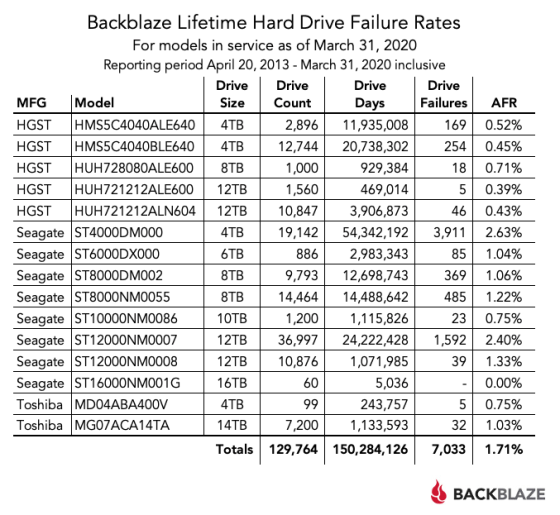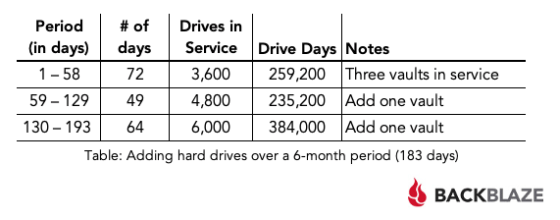Backblaze released HDD failure rate report of 130,000 or more units Q1 version in 2020, which HDD manufacturer showed strength?

Hard Drive Failure Rates: A Look at Drive Reliability
https://www.backblaze.com/blog/backblaze-hard-drive-stats-q1-2020/
Backblaze operates 132,339 HDDs at four data centers at the time of article creation, of which 2380 are used as boot drives and 129,959 as data drives. Of the 129,959 HDDs that are data drives, the target for data collection this time is 129,764 HDDs for testing and models for which the total number of units is less than 60 and significant data cannot be obtained. ..
Looking at the data at once, the average annual failure rate (AFR) in the first quarter of 2020 was 1.07%, the highest number since Backblaze started collecting data in 2013. Compared with the ARF of 1.56% in the first quarter of 2019, we have achieved a significant improvement. In the quarter, Backblaze had a model with zero failures for all three manufacturers, including HGST, Seagate, and Toshiba.

The model with zero failures was HGST's 8TB model 'HUH728080ALE600' and 12TB model 'HUH721212ALE600', Seagate's 16TB model 'ST16000NM001G', Toshiba's 4TB model 'MD04ABA400V', but Seagate and Toshiba's models still have days in operation. Backblaze also mentioned the few. It is explained that if one of the models with short operating days fails, Seagate's 16TB model has a high AFR of 7.25% and Toshiba's 4TB model has an AFR of 4.05%. On the other hand, the fact that there is no failure in the model of HGST, which has a sufficiently large number of drive days, is significant information. For example, if one 8TB model fails, the AFT is 0.40%, and if one 12TB model fails, the AFR is 0.26%, which is almost zero.
As mentioned above, test HDDs and models with a total number of less than 60 are not included in the total. For example, Toshiba's 8TB model 'HDWF180', 16TB model 'MG08ACA16TA' 20 units, and HGST's 10TB model 'HUH721010ALE600' are excluded models. The data published by Backblaze are always described as excluding these models.
In this report, Backblaze also looks back on the forecasts for the remaining quarters made in the
◆ Forecast 1: Gradually reduce 4TB HDDs to 15,000 by the end of 2019
・ Result: The number of 4TB HDDs at the end of 2019 was 34,908, which was not achieved.
・ Comment: I was too busy to handle it
◆ Prediction 2: Install at least 20 HDDs of 20 TB for the purpose of testing.
・ Result: 0 HDD of 20TB
・ Comment: There was no offer such as trial
◆ Expectation 3: Achieve 1 exabyte (1000 petabytes) of cloud storage capacity
・ Result: 850 petabytes at the end of 2019, but achieved 1 exabyte in March 2020
・ Comment: Go to that and quote the smart line 'I'm tired of waiting'
◆ Prediction 4: Test one or both HDDs that use HAMR or MAMR
・ Result: Neither HAMR nor MAMR possessed
・ Comment: I want to do it by the end of 2020
This is a table showing the lifetime failure rate of HDDs operating as of March 31, 2020, which was calculated from April 2013 to March 31, 2020. You can see that the overall performance of HGST is good.

This report also includes an explanation of the annual average failure rate (AFR), which is used as an indicator of failure rate. It is explained that the AFR at Backblaze is calculated from the following formula by aggregating 'the number of HDD failures' and 'the number of operating days of HDDs' for each model during the data aggregation period by model. Since 2020 is a leap year, one year is counted as 366 days.
[code] Annual average failure rate = (Number of HDD failures / (Drive days / 366 days) * 100 [/ code]
For example, let's find the annual average failure rate for the HDD named 'BB007' for half a year. HDDs with the model name BB007 broke down '28' in the 'semi-annual period' and were operating at '6000' at the end of the total period. If the number of drive days is 878,400 days, you can see that the annual average failure rate of BB007 is 1.17%.
[code] Annual average failure rate = (28 units / (878,400 days / 366 days)) * 100 = (28 / 2,400) * 100 = 1.17% [/ code]
In fact, Backblaze's formula for calculating the annual average failure rate does not use the number of HDDs at the end of the term. When calculating the annual average failure rate using the number of HDDs, the AFR becomes 0.93% as follows. This is inconsistent with the AFR calculated earlier, 1.17%.
[code] AFR = (28/6000) * (366/183) * 100 = (0.00467) * (2) * 100 = 0.93% [/ code]
Backblaze uses the number of drive days instead of the number of HDDs at the end of the term as a variable in the formula because the increase or decrease in the number of HDDs is the reason. It seems that the number of HDDs will change dynamically due to the increase in demand for
In the previous example of 'BB007', it was assumed that the following increase and decrease in HDDs was assumed. “Drive in Service” represents the number of HDDs that were in operation at that time, and while the number of HDDs reflects only the situation at the end of the period, the number of drive days includes fluctuations in the number of HDDs. I understand very well. Backblaze is said to adopt the drive days method that suits the actual conditions of its business operations.

The full version of the information used to create this report can be obtained from:
Backblaze Hard Drive Stats
https://www.backblaze.com/b2/hard-drive-test-data.html
Related Posts:
in Hardware, Posted by darkhorse_log







